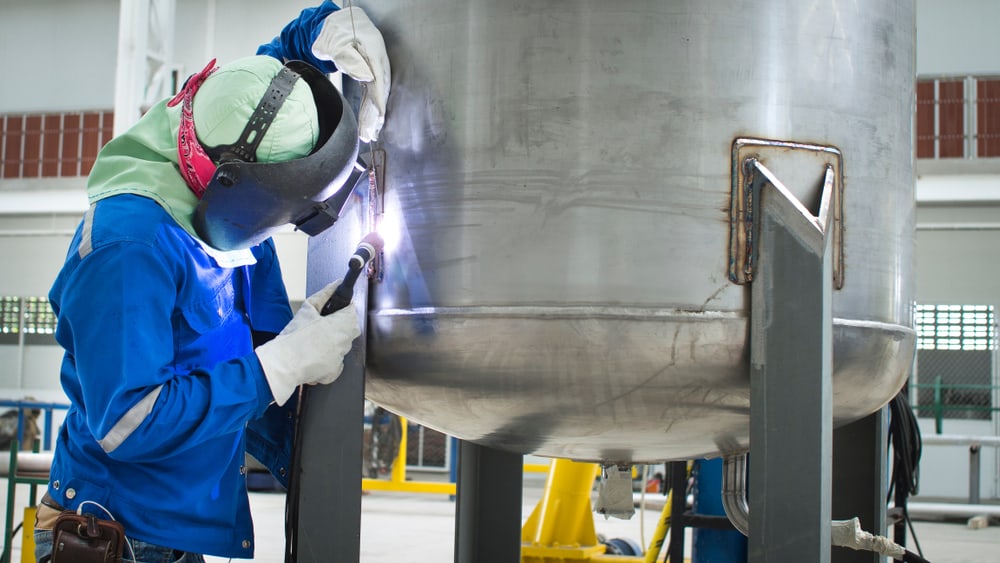
“Which is better, concrete or steel?” is a popular question around architectural firms and construction sites. The answers you hear are likely to change with each person you ask. While concrete has traditionally been preferred, steel is gaining popularity because its flexibility and lighter weight enable faster erection times and reduced labor costs. Reasons for the preference of steel become more obvious when these advantages are coupled with stainless steel’s aesthetically pleasing appearance and its durability and resistance to rust. Unsurprisingly, steel is a favored material for not only buildings, but also bridges, automobiles, trains, aircraft, spacecraft, industrial plants, power stations, and, of course, for tubing and piping used to transport everything from water to food products.
Stainless steel is often described as a “wonder” material because it can be used almost everywhere. Additionally, many welding processes can be employed to bond stainless steel. Such processes include shielded metal arc welding (SMAC), submerged arc welding (SAW), plasma arc welding (PAW), flux-cored arc welding (FCAW), and the most often used techniques: GMAW and GTAW. Although the ease of welding depends on the specific grade of stainless steel employed, safety concerns must be addressed regardless of the process implemented. Let’s examine these concerns and then take a look at some tips that when followed will contribute to stainless steel welding safety.
Safety Concerns of Stainless Steel Welding
Wide ranging stainless steel applications require welders to face an array of unique issues such as inclement weather, poor ventilation, cramped spaces, or even underwater workspaces. Working under these types of conditions can certainly threaten the safety of welders; however, there are even more dangerous hazards when performing stainless steel welding, as listed below.
Stainless Steel Welding Hazards
Welders that work with stainless steel are primarily threatened by the following three hazards:
- Toxic Fumes
The greatest hazard when welding stainless steel is the generation of toxic fumes. These fumes are virtually unavoidable as they are the result of the chromate chemicals used in steel production that become hexavalent chromium during the welding process. Chromium is an essential element that gives stainless steel its corrosion resistivity. Unfortunately, exposure to the fumes produced can lead to several health problems, such as:
- Dermatitis
- Respiratory irritation
- Eye and other organ damage
- Asthma (organizational)
- Pulmonary congestion
- Cancer (nasal, sinus or lung)
- UV Radiation
Ultraviolet (UV) radiation can also be a concern when arc welding. As a Group I carcinogen, this light can cause certain cancers. These include melanoma, which may infect the eyes or lungs.
Since stainless steel is very reflective in nature, UV exposure is only magnified when welding these materials, and extra skin and eye protection is critical.
- Electric Shock
Arc welding is an electrical process. Therefore, the possibility of electric shock also exists.
As illustrated by the list above, welding stainless steel can be very hazardous work. Effective measures and procedures, like the tips discussed in the following section, should be followed to ensure the welder’s safety.
Tips for Stainless Steel Welding Safety
It is no secret that welding can be dangerous. In fact, some estimates place hand welding at number 30 of the deadliest jobs in America. So, safety should always be a concern when welding. And when working with stainless steel this concern should only be heightened. An effective foundation for the establishment of a safety regimen that can be applied to welding in general, and to stainless steel welding in particular, is shown in the figure below.
The list of controls above can be utilized to establish a set of safety tips to protect welders when working with stainless steel. These safety tips are described below.
Stainless Steel Welding Safety Tips
By inverting the pyramid of controls, we can organize a set of safety tips in order of increasing importance to best protect stainless steel welders from harm.
Tip #1: Wear PPE
The use of protective equipment should be a given. This includes gloves, coveralls, and boots. However, special attention needs to be placed on the welding helmet and respirator. A good option is to wear a powered air purifying respirator, or PAPR.
Tip #2: Separate welding operations
Welding stations or jobs should be constructed with adequate spacing, if possible. This will prevent workers from being exposed to multiple processes simultaneously.
Tip #3: Use forced ventilation
Even if the facility where the job is done has ventilation, it is better to utilize forced ventilation near the welding process to quickly disperse fumes.
Tip #4: Choose the safest material
There are many grades of stainless steel available. Choosing the grade that contains a lower chromium content, but meets strength, temperature resistance and other requirements may help limit the fumes produced.
Tip #5: Employ orbital welding technology
By far, the best safety measure to take when welding stainless steel is to remove the welder from the immediate vicinity of the arc. This is accomplished by employing an automatic welding process, such as orbital TIG welding, where the weld head is controlled remotely.
MIG and TIG welding are the processes most often utilized for welding stainless steel piping and tubing. While slower, TIG stainless steel welding produces higher quality yields. And when an automated orbital process is used, many of the hazards associated with stainless steel welding can be significantly reduced.
Arc Machines, Inc. is an industry leader in supplying the highest-quality and most advanced welding equipment and service. Our experience and expertise in orbital welding systems will help you meet your stainless steel welding requirements while maximizing safety. For inquiries regarding products, contact sales@arcmachines.com. For service inquiries, contact service@arcmachines.com. Arc Machines welcomes the opportunity to discuss your specific needs. Contact us to arrange a meeting.




